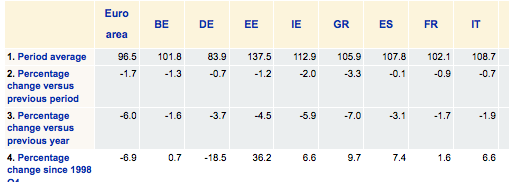The purpose of harmonised competitive indicators is to show changes in relative competitiveness of countries. They are are also consistent with the real effective exchange rates (EERs) of the euro.
This shows the divergence in competitiveness between a country like Germany De (improved competitiveness) and other countries like Greece and Ireland which have seen higher unit labour costs.
Harmonised competitive indicators in the EU (2011 Q1), source: ECB Stats based on unit labour costs indices for the total economy:
The ECB also show harmonised competitive indicators based on consumer price indexes. (CPI competitiveness)
The issue of competitiveness and relative prices becomes much more important in a single currency. This is because uncompetitive countries can’t rely on devaluing the exchange rate.

The result of competitiveness can be seen in statistics such as the current account. Countries which have become uncompetitive usually experience a large current account deficit. The below graphs shows how Greece has a current account deficit of 10%. This is unusually high and a signal of how uncompetitive Greece has become. Germany by contrast has a large current account surplus.

Current Account deficits in the Euro
Changes in EU Current Account Deficits

Issues in Competitiveness
- Power of Trades Unions. Some Euro countries have strong unions which resist pay cuts and new working practises. It is not just the power of unions but how they operate / co-operate with firms. For example, in Germany unions have a stronger legacy of working with firms; in France there are more cases of Union antagonism (such as resisting new working practises in printing of national daily newspapers)
- Labour Market Flexibility. The degree to which firms can hire and fire workers and easily expand production. Strong market regulation may discourage some firms from inwardly investing. Though it can also work both ways, if labour markets are too flexible, workers may struggle lack motivation because they fear losing job.
- Skills and motivation of young workers. Europe suffers from relatively high structural unemployment, especially amongst young people. This represents a loss of productive capacity. Despite unemployment, job vacancies remain unfilled.
- Rate of Technological innovation.
- Infrastructure. Levels of infrastructure and communication play a key role in determining competitiveness of country.
- Work Ethic. Hard to define, but at the risk of making generalisations some have suggested those in Southern Europe are more inclined to take it easy than in north Europe.
Current Account Deficits and Domestic Demand
The large current account deficits in southern Europe are not just due to competitiveness, but also domestic demand. Entry to the Euro saw a growth in capital inflows. This provided a boost to domestic demand which pushed up inflation and led to higher import spending.
Related


4 thoughts on “Competitiveness in Europe”
Comments are closed.